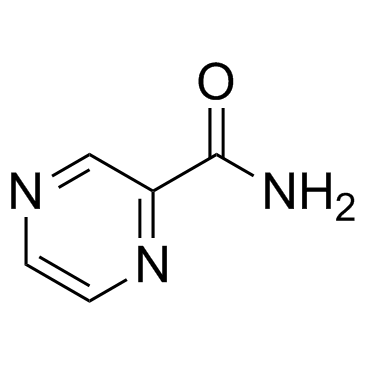pyrazinamide

pyrazinamide structure
|
Common Name | pyrazinamide | ||
|---|---|---|---|---|
| CAS Number | 98-96-4 | Molecular Weight | 123.113 | |
| Density | 1.4±0.1 g/cm3 | Boiling Point | 273.3±43.0 °C at 760 mmHg | |
| Molecular Formula | C5H5N3O | Melting Point | 189-191 °C(lit.) | |
| MSDS | Chinese USA | Flash Point | 119.1±28.2 °C | |
|
Cheminformatics analysis of assertions mined from literature that describe drug-induced liver injury in different species.
Chem. Res. Toxicol. 23 , 171-83, (2010) Drug-induced liver injury is one of the main causes of drug attrition. The ability to predict the liver effects of drug candidates from their chemical structures is critical to help guide experimental drug discovery projects toward safer medicines. In this st... |
|
|
Translating clinical findings into knowledge in drug safety evaluation--drug induced liver injury prediction system (DILIps).
J. Sci. Ind. Res. 65(10) , 808, (2006) Drug-induced liver injury (DILI) is a significant concern in drug development due to the poor concordance between preclinical and clinical findings of liver toxicity. We hypothesized that the DILI types (hepatotoxic side effects) seen in the clinic can be tra... |
|
|
Developing structure-activity relationships for the prediction of hepatotoxicity.
Chem. Res. Toxicol. 23 , 1215-22, (2010) Drug-induced liver injury is a major issue of concern and has led to the withdrawal of a significant number of marketed drugs. An understanding of structure-activity relationships (SARs) of chemicals can make a significant contribution to the identification o... |
|
|
A predictive ligand-based Bayesian model for human drug-induced liver injury.
Drug Metab. Dispos. 38 , 2302-8, (2010) Drug-induced liver injury (DILI) is one of the most important reasons for drug development failure at both preapproval and postapproval stages. There has been increased interest in developing predictive in vivo, in vitro, and in silico models to identify comp... |
|
|
Biochemical characterization of quinolinic acid phosphoribosyltransferase from Mycobacterium tuberculosis H37Rv and inhibition of its activity by pyrazinamide.
PLoS ONE 9(6) , e100062, (2014) Quinolinic acid phosphoribosyltransferase (QAPRTase, EC 2.4.2.19) is a key enzyme in the de novo pathway of nicotinamide adenine dinucleotide (NAD) biosynthesis and a target for the development of new anti-tuberculosis drugs. QAPRTase catalyzes the synthesis ... |
|
|
Simple and accurate quantitative analysis of 20 anti-tuberculosis drugs in human plasma using liquid chromatography-electrospray ionization-tandem mass spectrometry.
J. Pharm. Biomed. Anal. 102 , 9-16, (2014) A simple and accurate liquid chromatography (LC)-tandem mass spectrometry (MS/MS) method for the quantitation of 20 anti-tuberculosis (anti-TB) drugs in human plasma, was developed as a tool for therapeutic drug monitoring. Two protein precipitation methods w... |
|
|
Prediction of volume of distribution values in human using immobilized artificial membrane partitioning coefficients, the fraction of compound ionized and plasma protein binding data
Eur. J. Med. Chem. 44 , 4455-60, (2009) We developed an improved Lombardeo's method (J. Med. Chem., 2004) for prediction of VD ss in human. With Elog D substituted by log k IAM, together with f i (7.4) (the fraction of compound ionized at pH 7.4) and log f u (logarithmic fraction of compound unboun... |
|
|
Quantitative structure-activity relationship and complex network approach to monoamine oxidase A and B inhibitors.
J. Med. Chem. 51 , 6740-51, (2008) The work provides a new model for the prediction of the MAO-A and -B inhibitor activity by the use of combined complex networks and QSAR methodologies. On the basis of the obtained model, we prepared and assayed 33 coumarin derivatives, and the theoretical pr... |
|
|
The B vitamins nicotinamide (B3) and riboflavin (B2) stimulate metamorphosis in larvae of the deposit-feeding polychaete Capitella teleta: implications for a sensory ligand-gated ion channel.
PLoS ONE 9(11) , e109535, (2014) Marine sediments can contain B vitamins, presumably incorporated from settled, decaying phytoplankton and microorganisms associated with decomposition. Because B vitamins may be advantageous for the energetically intensive processes of metamorphosis, post-met... |
|
|
Detection of residual rifampicin in urine via fluorescence quenching of gold nanoclusters on paper.
J. Nanobiotechnology 13 , 46, (2015) Rifampicin or rifampin (R) is a common drug used to treat inactive meningitis, cholestatic pruritus and tuberculosis (TB), and it is generally prescribed for long-term administration under regulated dosages. Constant monitoring of rifampicin is important for ... |